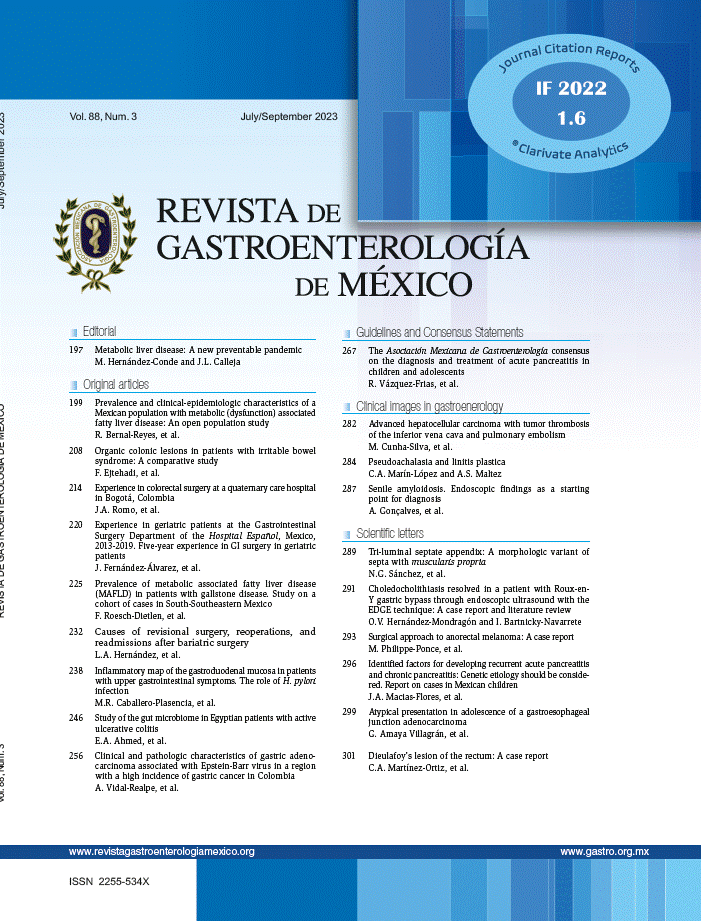We sincerely appreciate the valuable commentary sent by Dr. Crespo et al., regarding our article on the gastrointestinal adverse effects of antidiabetics, in particular the glucagon-like peptide-1 receptor agonists (GLP-1RAs). There is growing interest in those drugs because of their multiple mechanisms of action, including the incretin effect with increased insulin secretion by beta cells, improvement in insulin sensitivity, reduced glucagon secretion, and the decrease in food intake through induced satiety.1 Their observations on the perioperative and endoscopic consequences of delayed gastric emptying induced by GLP-1RAs stand out for their clinical relevance, constituting an aspect that deserves particular attention in medical practice and future research.
GLP-1RAs have revolutionized the treatment of diabetes mellitus (DM) and obesity, positioning themselves as one of the most effective and utilized therapies worldwide. However, their capacity for delaying gastric emptying poses significant clinical risks, especially in procedures that require deep sedation or general anesthesia. As Crespo et al. correctly pointed out, recent studies have associated GLP-1RA use with a higher risk of aspiration pneumonia during endoscopic procedures,2 with evidence on this aspect gradually increasing. In addition, a recent retrospective cohort study reaffirmed the association of GLP-1RA use with a small but significant risk of aspiration pneumonitis in diabetic patients that underwent elective upper gastrointestinal endoscopy.3
There is also contradictory evidence, such as that reported in the published study by Barlowe et al., who retrospectively analyzed 6,806,046 procedures in adult patients with DM who underwent ambulatory upper gastrointestinal endoscopy between 2005 and 2021. The main findings of their study showed that adverse pulmonary events after upper gastrointestinal endoscopy are rare, with an incidence that varied from 6 to 25 events per 10,000 procedures. Upon comparing GLP-1RAs with dipeptidyl peptidase 4 (DPP4) inhibitors, the crude relative risks were the following: aspiration (0.67; 95% CI 0.25-1.75), aspiration pneumonia (0.95; 95% CI 0.40-2.29), pneumonia (1.07; 95% CI 0.62-1.86), and respiratory failure (0.75; 95% CI 0.38-1.48).4 Those data are similar to the results of another comparative cohort study that described no increased risk of pulmonary aspiration during upper gastrointestinal endoscopy in adults with DM who used GLP-1RAs, compared with other medications.5
A meta-analysis of 13 studies that included 84,065 patients found that GLP-1RA use was associated with greater retained gastric content and a higher frequency of aborted procedures during upper gastrointestinal endoscopy. However, there were no significant differences in the aspiration rates between GLP-1RA users and nonusers.6
The recommendation of the American Society of Anesthesiologists (ASA) to suspend GLP-1RAs before endoscopic or surgical procedures is a prudent approach, based on the available preliminary evidence.7 Nevertheless, as stated by Crespo et al., that recommendation has been controversial in gastroenterologic clinical practice. The American Gastroenterological Association (AGA) has emphasized the need to avoid making generalizations that may compromise patient care, based on the current evidence.8
We agree with the comments by Crespo et al. and we consider it especially relevant to highlight the fact that recent studies have proposed alternative strategies, such as carrying out prolonged fasting and liquid diet before the procedure to minimize residual gastric content, without the need to suspend GLP-1RAs.9 On the other hand, in the case of a GLP-1RA treatment suspension strategy, according to current recommendations, perioperative glucose management involves the evaluation of glucose control before surgery, adequate preoperative management of glucose-lowering therapies, and repeated blood glucose monitoring on the day of surgery. In such a scenario, novel technologies for the management of diabetes that include continuous glucose monitoring, insulin pumps, and closed-loop glucose control systems are being considered for addressing the needs not covered in the perioperative care of diabetes.10 All those approaches require additional validation, but they are a promising alternative for balancing metabolic control and perioperative risk.
Based on the above, we put forward the following possible future lines of research:
- 1
Multicenter prospective studies: To evaluate the true risk of aspiration and respiratory complications in patients treated with GLP-1RAs who undergo endoscopic procedures indicated in different preoperative management strategies.
- 2
Evaluation through gastric ultrasound: To explore the role of gastric ultrasound as a predictive tool for the risk of aspiration in this group of patients.
- 3
Risk prediction models: To develop risk stratification algorithms for guiding the individualized decisions on suspending or maintaining GLP-1RAs in the perioperative context.
- 4
Metabolic impact of temporary suspension: To study the metabolic consequences of temporarily suspending GLP-1RAs, including possible decompensated diabetes and long-term adherence.
We trust this debate will foment new research and guide the creation of recommendations based on solid evidence. Once again, we thank Dr. Crespo et al. for their perspicacious contribution that underlines the emerging clinical challenge with significant implications for interdisciplinary practice.
Ethical considerationsThe authors of this work declare that no experiments on humans or animals were conducted for this research, and there are no conflicts regarding confidentiality, given that no patient data appear in this article. In addition, informed consent was not required because no data of persons or patients were utilized.
Financial disclosureNo financial support was received in relation to this article.
The authors declare that there is no conflict of interest.



